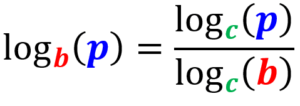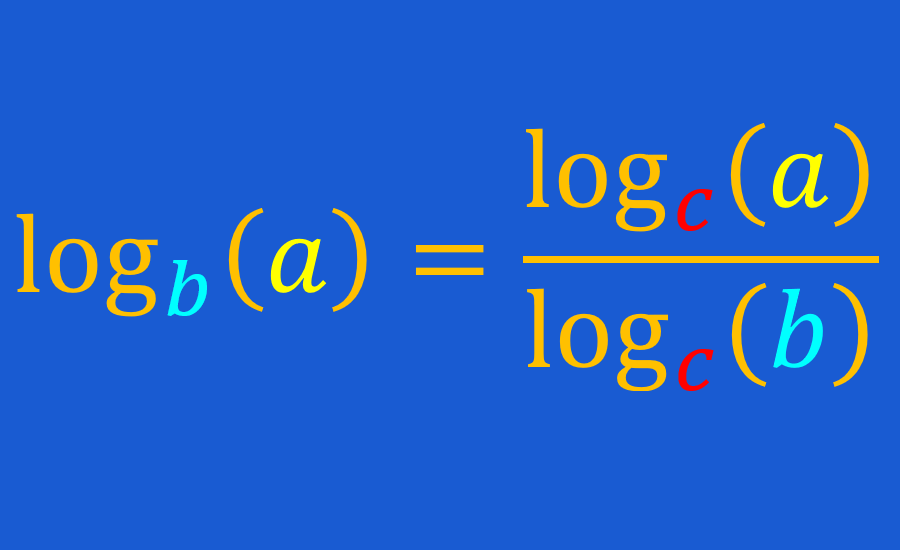The properties of logarithms, also known as the laws of logarithms, are useful as they allow us to expand, condense, or solve equations that contain logarithmic expressions. Here, we will learn about the properties and laws of logarithms.
We will learn how to derive these properties using the laws of exponents. Also, we will look at some examples of the application of these properties.
Property of the logarithm of a product
The logarithm of a product rule indicates that the multiplication of two or more logarithms with the same base can be written as the sum of the individual logarithms:

Proof of this property
Suppose we have $latex x=\log_{b}(p)$ and $latex y=\log_{b}(q)$. We can write each of these equations in exponential form:
⇒ $latex {{b}^x}=p$
⇒ $latex {{b}^y}=q$
Multiplying the exponential terms p and q, we have:
$latex {{b}^x}\times {{b}^y}=pq$
Since the base is common, we can apply the product of exponents rule to add the exponents and combine the base:
$latex {{b}^{x+y}}=pq$
Taking the logarithm with base “b” of both sides, we have:
$latex \log_{b}({{b}^{x+y}})=\log_{b}(pq)$
Applying the rule of the logarithm of a power (which we will see later), we have:
$latex (x+y)\log_{b}(b)=\log_{b}(pq)$
$latex (x+y)=\log_{b}(pq)$
Now, we substitute the values of x and yin the equation obtained:
| $latex \log_{b}(p)+\log_{b}(q)=\log_{b}(pq)$ |
EXAMPLES
- Applying the product property to solve the expression $latex \log_{4}(8)+\log_{4}(32)$, we have:
$latex \log_{4}(8)+\log_{4}(32)=\log_{4}(8\times 32)$
$latex =\log_{4}(256)$
$latex =4$
- Solving the expression $latex \log(25)+\log(4)$, we have:
$latex \log(25)+\log(4)=\log(25\times 4)$
$latex =\log(100)$
$latex =2$
Property of the logarithm of a quotient
The rule or law of the logarithm of a quotient indicates that the ratio of two logarithms with the same bases is equal to the difference of the logarithms

Proof of this property
Let’s define the equations $latex x=\log_{b}(p)$ y $latex y=\log_{b}(q)$. Therefore, we can rewrite them in their exponential form:
⇒ $latex {{b}^x}=p$
⇒ $latex {{b}^y}=q$
If we divide the exponential terms p and q, we have:
$latex \frac{{{b}^x}} {{{b}^y}}=\frac{p}{q}$
Since the base is common, we apply the exponent quotient rule to combine the base and subtract the exponents:
$latex {{b}^{x-y}}=\frac{p}{q}$
Now, we can take the logarithm with base “b” of both sides:
$latex \log_{b}({{b}^{x-y}})=\log_{b}(\frac{p}{q})$
If we apply the rule of the logarithm of a power (which we will see later), we have:
$latex (x-y)\log_{b}(b)=\log_{b}(\frac{p}{q})$
$latex (x-y)=\log_{b}(\frac{p}{q})$
If we substitute the values of x and y into the equation obtained, we have:
| $latex \log_{b}(p)-\log_{b}(q)=\log_{b}(\frac{p}{q})$ |
EXAMPLES
- We can solve the expression $latex \log_{5}(50)-\log_{5}(2)$ with the quotient property:
$latex \log_{5}(50)-\log_{5}(2)=\log_{5}(\frac{50}{2})$
$latex =\log_{5}(25)$
$latex =2$
- If we apply the quotient property to $latex \log_{3}(108)-\log_{3}(4)$, we have:
$latex \log_{3}(108)-\log_{3}(4)=\log_{3}(\frac{108}{4})$
$latex =\log_{3}(27)$
$latex =3$
Property of the logarithm of a power
According to the property of the logarithm of a power, the logarithm of a number “p” with exponent “n” is equal to the product of the exponent and the logarithm of the number (without the exponent):

Proof of this property
Let’s define the equation $latex x=\log_{b}(p)$ and we are going to write it in its exponential form:
⇒ $latex {{b}^x}=p$
We can raise the power of n both sides of the equation:
$latex {{({{b}^x})}^n}={{p}^n}$
⇒ $latex {{b}^{xn}}={{p}^n}$
If we take the logarithm with base “b” of both sides, we have:
$latex \log_{b}({{b}^{xn}})=\log_{b}({{p}^n})$
$latex xn\log_{b}(b)=\log_{b}({{p}^n})$
$latex xn=\log_{b}({{p}^n})$
Substituting the value of x in the obtained equation, we have:
| $latex n\log_{b}(p)=\log_{b}({{p}^n})$ |
EXAMPLES
- We solve the expression $latex \log_{8}({{64}^2})$ by applying the property of the logarithm of a power:
$latex \log_{8}({{64}^2})=2\log_{8}(64)$
$latex =2(2)$
$latex =4$
- Applying the property of the logarithm of a power in the expression $latex \log({{100}^4})$, we have:
$latex \log({{100}^4})=4\log(100)$
$latex =4(2)$
$latex =8$
Property of change of base of logarithms
According to the property of change of base of logarithms, we can rewrite any logarithm as the ratio of two logarithms with a new base:

Proof of this property
Suppose we have $latex x=\log_{b}(p)$. We can write this in its exponential form:
⇒ $latex {{b}^x}=p$
Applying the logarithm with base “c” to both sides, we have:
$latex \log_{c}({{b}^{x}})=\log_{c}(p)$
We use the logarithm of a power rule:
$latex (x)\log_{c}(b)=\log_{c}(p)$
Now, we can solve for x:
$latex x=\frac{\log_{c}(p)}{\log_{c}(b)}$
Now, we substitute the value of x:
| $latex \log_{b}(p)=\frac{\log_{c}(p)}{\log_{c}(b)}$ |
EXAMPLES
- We apply the property of change of bases to solve $latex \log_{8}(16)$:
$latex \log_{8}(16)=\frac{\log_{2}(16)}{\log_{2}(8)}$
$latex =\frac{4}{3}$
- Solving the expression $latex \log_{27}(81)$, we have:
$latex \log_{27}(81)=\frac{\log_{3}(81)}{\log_{3}(27)}$
$latex =\frac{4}{3}$
Other properties
- The logarithm of 1 to any nonzero finite base equals zero.
Proof of this property
We can prove this by rewriting it in its exponential form:
$latex \log_{b}(1)=0$
⇒ $latex {{b}^0}=1$
- The logarithm of any positive number to the same base is equal to 1.
Proof of this property
Again, we can prove this by rewriting it in its exponential form:
$latex \log_{b}(b)=1$
⇒ $latex {{b}^1}=b$
See also
Interested in learning more about logarithms? Take a look at these pages:




